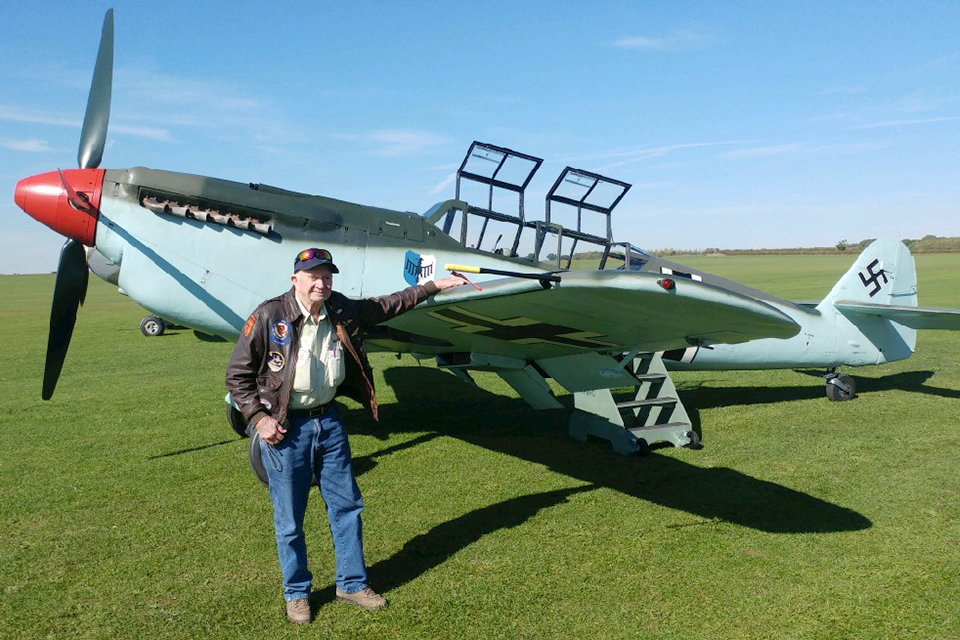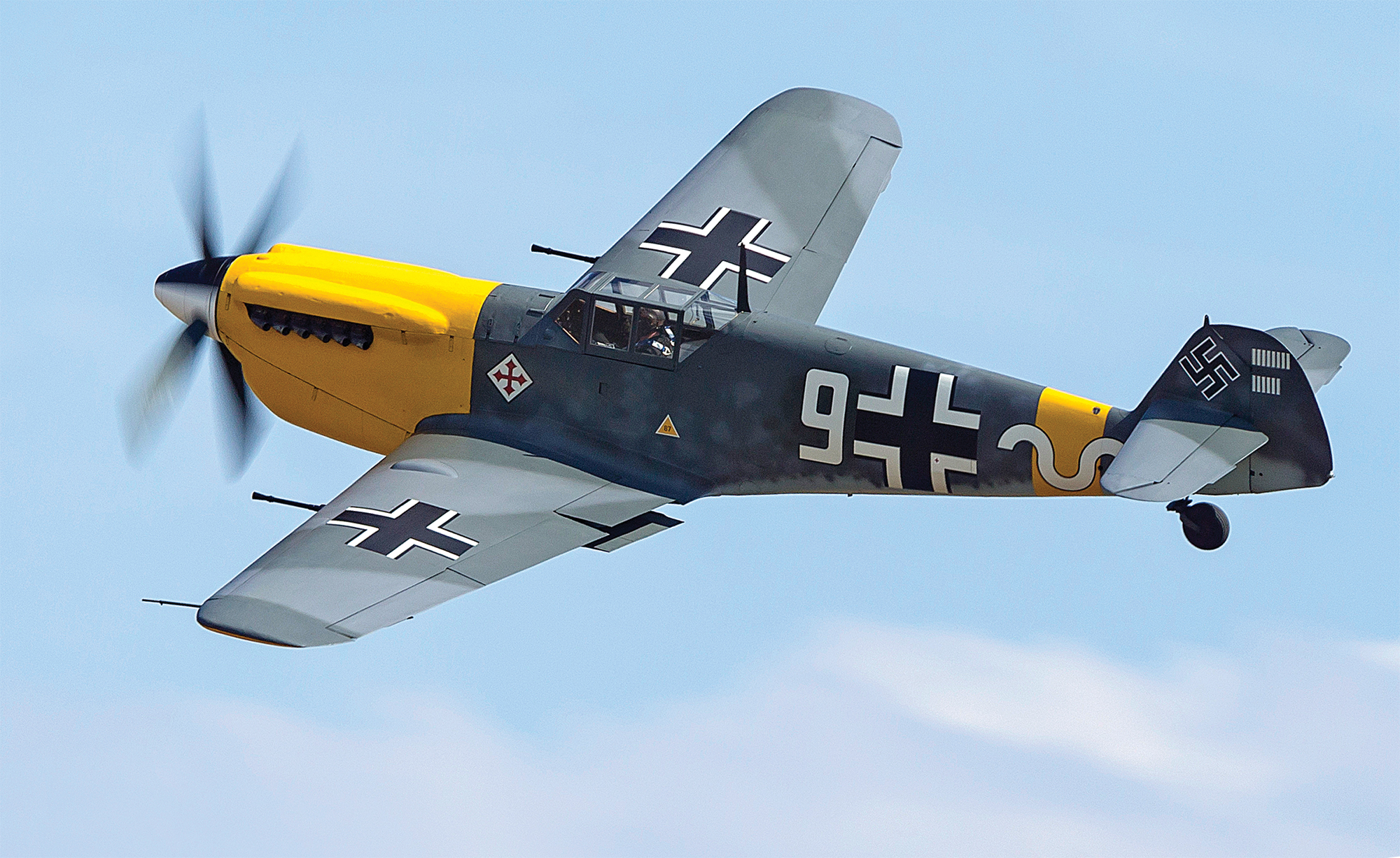Spanish-built versions of the Me-109 lend an air of authenticity to World War II feature films.
If ever a pair of warbirds owed much of their survival to the film industry, it is the Supermarine Spitfire and the Messerschmitt Me-109—or more often in the latter case, its stand-in, the Hispano Aviación HA-1112 Buchón. Ever since the 1969 Hollywood epic Battle of Britain, these perpetual adversaries have been kept flying to awe crowds at airshows and to be ready to dogfight again the next time a World War II movie project comes around, most recently 2017’s Dunkirk.
After Battle of Britain, 16 Buchóns were presented in lieu of payment to the film’s chief stunt pilot, Wilson “Connie” Edwards, who traded two back to the production company for a Spitfire Mk. IX and kept the remainder at his ranch in Big Spring, Texas. Over the years he sold off his Spanish Messerschmitts, some ending up in museums either in their original form or modified to look more like Me-109s, others restored to flying status. In 2015 Edwards sold the last six of them to Air Leasing Ltd. in Sywell, Northamptonshire, England. Three of those recently returned to the air in rapid succession.
The Me-109’s Spanish connection dates back to its use by the German Condor Legion during the Spanish Civil War, after which some were sold to the victorious Nationalist regime of General Francisco Franco Bahamonde. In 1942 Hispano Aviación obtained a license to produce Me-109G-2s, and its version had undergone several changes in engine, armament and overall configuration by the time the HA-1112-M1L made its first flight on March 29, 1954. Powered by a Rolls-Royce Merlin 500-45 engine driving a Rotol propeller—both British imports more readily associated with its enemy, the Spitfire—the HA-1112 had a maximum speed of 413 mph, respectable for a 109 but irrelevant in view of its primary role, patrolling Spain’s North African colonial territories during the jet age. By the time of its retirement in December 1965, the Buchón’s future had already been presaged in 1957, when an HA-1112-K1L (a 1951 version using a Hispano-Suiza engine) portrayed the Me-109F of German ace Hans-Joachim Marseille in Der Stern von Afrika.

When filming began on Battle of Britain, producer Harry Saltzman bought eight of the retired Merlin-powered HA-1112s from the Spanish government, plus enough parts to build 20 more. Edwards flew the lead Spitfire and assembled what he called “a squadron of bush pilots” to operate the others. As the filming went over budget, many scenes had to be recycled (as anyone who sees the movie multiple times will notice) and Edwards was offered the HA-1112s as payment. Already wealthy from the oil business, he said, “Fine, I’ll take the aircraft as IOUs,” dismantled them and shipped the crated fuselages, wings and tail units to his ranch in Texas.
Between Edwards’ care and the arid weather conditions where they were stored, the Buchóns remained remarkably well preserved over the decades, down to their original movie warpaint. When Air Leasing got around to restoring the most recent trio in 2017, it found little repairing or replacing to do aside from a basic overhaul.
The first of the three to regain flying status, in November 2017, was HA-1112-M4L serial no. C.4K-112, the sole Buchón built as a two-seat, dual-control trainer (although one of the fighters was modified with a bubble canopy for the air-to-air photography). During the filming two actual Battle of Britain aces, Adolf Galland and Robert Stanford Tuck, got to fly in the two-seater. Since the HA-1112-M4L’s recent return to flight, Air Leasing Ltd. has been offering rides in it to the general public.
HA-1112-M1L C.4K-99 was next to fly, in April 2018, bearing Battle of Britain livery and the yellow numeral 7. The latest, HA-1112-M1L C.4K-105, made its first takeoff in more than 50 years from Sywell Aerodrome in June 2018. Its markings scheme is based on that of Me-109F-4 “White 9” flown by 93-victory ace Edmund Rossmann of Jagdgeschwader (fighter wing) 52 over Russia in September 1941.
Prior to the latest trio, several earlier buyers had made their Buchóns airworthy. C.4K-67 was restored by Spitfire Ltd. and currently resides at St. Helier on the Channel Island of Jersey. The Messerschmitt Foundation obtained an original Daimler-Benz DB 605 engine and in 2004 completed C.4K-75 as an Me-109G-4 for airshow appearances in Germany (with a small red, gold and black national flag on the vertical stabilizer in place of the Nazi swastika). MaierMotors also converted C.4K-64 to Me-109G-4 configuration with a DB 605 engine. It returned to flight in August 2015, and now operates from Jerry Yagen’s Military Aviation Museum in Virginia Beach, Va. C.4K-130 had an Allison engine with a Douglas DC-3 propeller installed inside a cowling resembling that of an Me-109G-10, and now flies with the Erickson Aircraft Collection out of Madras, Ore. C.4K-172, sporting the markings of Galland’s Me-109E during the Battle of Britain, is currently based at the Cavanaugh Flight Museum in Addison, Texas.
The latest of Edwards’ Buchóns to “see action” on the silver screen was C.4K-102, which returned to England in 1993 after being sold to the Real Aeroplane Company. After an extensive restoration, in 2006 it was sold to Spitfire Ltd. and in 2016 to Historic Flying Ltd., which hangars the fighter at Duxford. In 2017 C.4K-102 was cast in Dunkirk.
Sadly, Connie Edwards’ remarkable thrill-filled life came to an end on May 3, 2019, at age 85. Having been “shot down” 72 times in Spitfires and 128 times in Buchóns during filming of Battle of Britain, he once said, “I’ve probably lived more lives than anybody I know.” Part of his continuing legacy are three more airborne Spanish Messerschmitts, ready to help fill out a Staffel of “bad guys” for the next airshow or cinematic dogfight.
This feature originally appeared in the September 2019 issue of Aviation History. Subscribe here!





